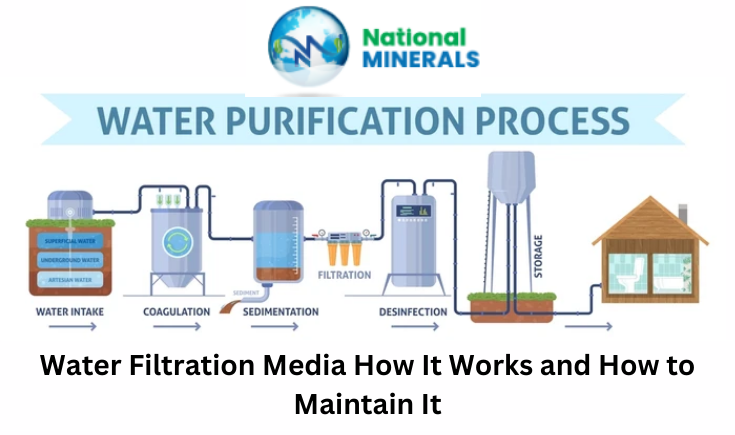Access to clean and safe water is a fundamental necessity for health and well-being. Water filtration systems play a critical role in ensuring that the water we consume is free from contaminants and safe for use. At the core of these systems is the water filtration media, the material responsible for trapping impurities and purifying the water. Understanding how water filtration media works and how to maintain it is essential for ensuring the longevity and efficiency of water filtration systems. This blog explores the mechanisms of water filtration media and provides practical tips for maintaining these crucial components.
How Water Filtration Media Works
Water filtration media are materials used in water filtration systems to remove contaminants from water. Different types of filtration media target various types of impurities, ensuring comprehensive water purification. Here are some common types of water filtration media and their functions:
1. Activated Carbon
- Mechanism:
Activated carbon, also known as activated charcoal, works through a process called adsorption. The carbon has a large surface area with many pores that trap contaminants as water passes through.National Mineral Is a
Leading Manufacturer In India For Activated Carbon
- Target Contaminants: Activated carbon is highly effective at removing organic compounds, chlorine, and other chemicals that affect the taste and odour of water. It can also reduce the levels of pesticides and herbicides.
2. Ceramic Filters
- Mechanism: Ceramic filters have small pores that physically block bacteria, cysts, and sediment from passing through. The filtration occurs through mechanical filtration, where the contaminants are larger than the pore size of the ceramic.
- Target Contaminants:Ceramic filters are excellent for removing bacteria, protozoa, and sediment from water, making it microbiologically safe to drink.
3. Ion Exchange Resins
- Mechanism: Ion exchange resins work by exchanging ions in the water with ions attached to the resin. This chemical process removes unwanted ions, such as calcium and magnesium, which cause hardness in water.
- Target Contaminants: Ion exchange resins are primarily used to soften water by removing hardness minerals. They can also remove heavy metals like lead and copper.
4.Reverse Osmosis Membranes
- Mechanism: Reverse osmosis (RO) membranes use a semipermeable membrane to remove a wide range of contaminants. Water is forced through the membrane under pressure, leaving impurities behind.
-
Target Contaminants: RO membranes can remove dissolved solids, bacteria, viruses, and
many types of chemical contaminants, providing high-purity water.
5.KDF Media
- Mechanism: KDF (Kinetic Degradation Fluxion) media use a redox (reduction-oxidation) process to remove contaminants. The media consists of copper and zinc granules that create an electrochemical reaction, reducing or removing chlorine, heavy metals, and other contaminants.
- Target Contaminants: KDF media are effective at removing chlorine, heavy metals, and controlling the growth of bacteria, algae, and fungi.
How to Maintain Water Filtration Media
Proper maintenance of water filtration media is crucial for ensuring the longevity and effectiveness of your water filtration system. Here are some key maintenance practices:
1.Regular Replacement
- Schedule: Different types of filtration media have varying lifespans. It is important to follow the manufacturer’s recommendations for replacement intervals. For example, activated carbon filters typically need replacement every 3-6 months, while RO membranes can last 2-3 years.
- Signs of Wear: Monitor for signs that the media need replacement, such as a decline in water quality, reduced flow rate, or changes in taste and odour
2.Cleaning
- Backwashing: Some filtration systems, particularly those using granular media like sand or KDF, require periodic backwashing to remove trapped contaminants and prevent clogging. Backwashing involves reversing the water flow through the media to flush out impurities.
- Ceramic Filters: Ceramic filters can be cleaned by scrubbing the surface with a brush to remove accumulated contaminants. Regular cleaning helps maintain the filter’s effectiveness and extends its lifespan.
3.Sanitization
- Prevent Bacterial Growth: To prevent bacterial growth in the filtration system, it is essential to sanitise the system periodically. This can involve using a sanitizing solution recommended by the manufacturer or a diluted bleach solution. Ensure the system is thoroughly rinsed after sanitization to remove any residual chemicals.
- Storage: If the filtration system will not be used for an extended period, remove and dry the filtration media. Store them in a clean, dry place to prevent bacterial growth and degradation.
4.Monitoring and Testing
- Mechanism: Reverse osmosis (RO) membranes use a semipermeable membrane to remove a wide range of contaminants. Water is forced through the membrane under pressure, leaving impurities behind.
- Regular Testing: Test the filtered water regularly to ensure the filtration system is working effectively. Home testing kits are available for checking common contaminants like chlorine, hardness, and pH levels. For comprehensive testing, consider using a professional water testing service.
5.Professional Servicing
- Expert Maintenance: For complex systems, such as whole-house filtration systems or industrial applications, regular professional servicing is recommended. Professionals can perform thorough inspections, maintenance, and replacements, ensuring the system operates at peak efficiency.
Conclusion
High-quality water filtration media are essential for ensuring the purity and safety of drinking water. Understanding the different types of filtration media and their mechanisms allows you to choose the right system for your needs. Regular maintenance, including timely replacement, cleaning, sanitization, and monitoring, is crucial for maintaining the effectiveness and longevity of water filtration systems.
media are essential for ensuring the purity and safety of drinking water. Understanding the different types of filtration media and their mechanisms allows you to choose the right system for your needs. Regular maintenance, including timely replacement, cleaning, sanitization, and monitoring, is crucial for maintaining the effectiveness and longevity of water filtration systems.
National Minerals
is a high quality Manufacturer in Activated Carbon and filtration Media in India So National Minerals is top Manufacturer in India.

